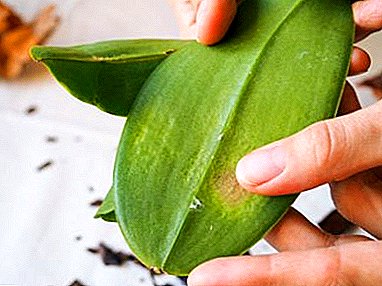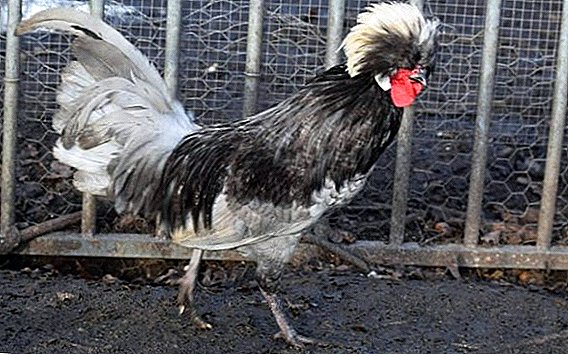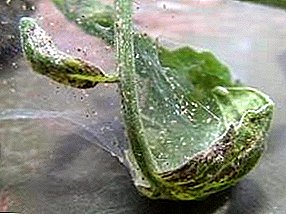
Orchid is a flower, the main difference of which is its unique flowering and exoticism. Sometimes it happens that the plant is attacked by parasites that prevent it from developing and growing normally. The most common insect is the spider mite. From the article we learn what this insect is, what is dangerous for the plant, how it appears, how to deal with it and how it carries out prevention from spider mites.
Insect characteristic
Definition
Spider mite - a rather dangerous parasite attacking an orchid. It does not belong to insects, but belongs to arachnids. This is a very distant relative of spiders and scorpions. A distinctive feature is the number of limbs (the tick has 4 pairs, and all other insects are only 3). There are about 1000 species in the family, some individuals have adapted to life even in Antarctica.
How does it differ from other species?
- Mite has the ability to weave a thin cobweb, this explains its name.
- There is a slowdown in the development of young, if the humidity is too high.
- Loves dry and warm climate.
- Spider mite can cause fungal, viral, bacterial diseases.
- It parasitizes plants only.
- It has 8 paws and a solid body.
- He has complex eyes, antennae and wings.
What does it look like?
 The body is oval in shape, sizes range from 0.3-0.6 millimeters. The hue depends on what the tick consumes, most often the color is reddish or green. Although adults possess 4 pairs of legs, their movements are constrained and slow.
The body is oval in shape, sizes range from 0.3-0.6 millimeters. The hue depends on what the tick consumes, most often the color is reddish or green. Although adults possess 4 pairs of legs, their movements are constrained and slow.
In the process of life, the pest weaves a web, enveloping the buds, foliage, flower stalk. It protects future generations from external factors. Spider mite develops very quickly. Maturity reaches after 15-20 days. The newly appeared tick has only 6 legs, after 2-3 days 2 more appear.
What is dangerous?
Hazard description
Tick instantly damages the flower compounds. Hiding under fallen leaves and in the ground. The level of danger depends on the number of individuals and the area affected. Consequences for orchids - the stem weakens, the intensity of photosynthesis decreases. Ticks can cause various infections. If you do not start to fight it in time or choose the wrong method, there is a considerable chance of destroying not only the orchid, but also other indoor plants.
How does a flower strike?
At first, the spider mite drinks juice from the sinuses of the flower, the base of the stem. In the first days, the tick lives on the walls of the tank, and then crawls onto the orchid itself.. A certain period of time he is in the so-called "dream". But the year comes favorable conditions, the pest begins active reproduction. The parasite is located on the inner side of the leaf, after some period it pierces the leaf plate and drinks juice from it. White spots and patches of cobwebs are a clear sign of a tick.
How to inspect the plant?
Unfortunately, the human eye can notice it when most of the leaf is damaged. In the initial stage of reproduction, it is almost impossible to see the spider mite with the naked eye.
Signs of spider mites:
- Light spots are formed on the plates, which eventually become larger.
- Orchid gradually fades.
- The leaves curl and dry.
- The manifestation of the web.
A photo
The photo shows what an orchid looks like, struck by a spider mite.


Why can a pet be especially vulnerable?
Parasites penetrate open windows or they are brought in with new flowers. The orchid is very vulnerable if the air temperature is too high and the humidity is low. Protection mechanisms are also weakened due to sudden changes in temperature, poor lighting, frequent fertilization.
Step by step instructions how to get rid
Changing conditions
Ticks grow quickly in dry airtherefore the humidity should be optimal.
It can be increased by:
- Perform watering.
- Place the flower in a plastic bag.
- So keep for at least 3 days.
This procedure will increase moisture and kill the enemy.
Important! The created greenhouse effect may adversely affect the pet. It is not recommended to do this for more than 3 days. There are signs of wilting - the package opens a little or completely retracts.
Washing with dishwashing detergent
How to deal with the parasite at home with detergents? You will need to make a solution of 1 tablespoon per 1 liter of liquid. It is allowed to make treatment with ordinary water mixed with soap. The number of ticks will fall at times. It is also worth thoroughly rubbing the place where the pot stood. Parts of the plant that are badly damaged are removed and disinfected.
Treatment with special preparations
 You can use biological, chemical and folk remedies.. Pesticides include "Aktelik" - they are treated 2 times with an interval of a week. Since the drug is too poisonous, it can only be used outdoors. One ampoule is diluted in a liter of water. Spray the resulting solution. There is another remedy called Apollo.
You can use biological, chemical and folk remedies.. Pesticides include "Aktelik" - they are treated 2 times with an interval of a week. Since the drug is too poisonous, it can only be used outdoors. One ampoule is diluted in a liter of water. Spray the resulting solution. There is another remedy called Apollo.
Application effective against larvae. Impact on mature individuals is insignificant. In 5 liters of liquid dilute 2 milliliters of Apollo, and then process the orchid twice.
- Acarin. After only a few hours, the spider mite stops consuming juice, and dies on the second day. Dosage - 4 liters of water 2 milliliters of chemical. It is enough to spray 4 times.
- Fitoderm. The composition includes the products of the vital activity of the inhabitants of the soil. Processing is done indoors. It is necessary to mix 3 milliliters of substance and 2 liters of water. As in the previous case, enough 4 times.
Folk methods of struggle
- It is necessary to take medical alcohol and cotton wool tampons. Affected parts of the orchid gently wipe previously moistened swab. But first you need a test - wetted a small area. The web has disappeared, and the plant has a healthy appearance - you can continue the procedure.
- Citrus peel weighing 100 grams, filled with water, boiled, and then infused for 3 days. Spraying should be done every 4-5 hours.
Prevention of infection and precautions
It’s not enough to know how to get rid of pests, still need to be done periodically prevention:
- Maintain normal moisture.
- Once a month to process a biological drug.
- In time to clean fallen leaves.
- Maintain optimum temperature.
Orchid is a capricious, but surprisingly beautiful plant. To achieve colorful flowering and health of the bush can be with proper and quality care. To prevent tick infestation, it is necessary to regularly spray orchid with water or weak biological solutions.












